
Photographic History of the United States Navy
ARCHIVE
| NavSource Main Page | FAQ | Contact us | Search NavSource |
 |
NavSource Naval History Photographic History of the United States Navy |
DESTROYER ARCHIVE |
 3 officers and 18 men were lost in Chauncey's sinking and remain on duty; two other sailors were lost earlier in Chauncey's career as well:
3 officers and 18 men were lost in Chauncey's sinking and remain on duty; two other sailors were lost earlier in Chauncey's career as well:| Click On Image For Full Size Image |
Size | Image Description | Contributed By And/Or Copyright |
|
|---|---|---|---|---|
| Namesake |
||||
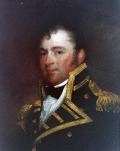 0500308 |
483k | Isaac Chauncey, born in Black Rock, Connecticut, 20 February 1779, was appointed a Lieutenant in the Navy from 17 September 1798. He fought with gallantry in the West Indies during the Quasi-War with France; in the Mediterranean during the War with the Barbary Powers; and commanded John Adams (1804-5), Hornet (1805-6), Washington and the Mediterranean Squadron (1815-1820). Perhaps his most outstanding service was during the War of 1812 when he commanded the naval forces on Lake Ontario, conducting amphibious operations in cooperation with the Army, and containing the large British squadron stationed there. His last service was as member, and, for four years, President, of the Board of Navy Commissioners. Commodore Chauncey died in Washington 27 January 1840. Commodore Isaac Chauncey, USN (1772-1840) oil on wood, 26" by 21.5", by Gilbert Stuart (1775-1828). Painted circa 1818. Painting in the U.S. Naval Academy Museum Collection. Transferred from the U.S. Naval Lyceum, 1892. Naval History & Heritage Command photo KN-10889 | Tony Cowart/Robert M. Cieri | |
| USS Chauncey (Destroyer No. 3) |
||||
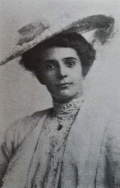 0500341 |
66k | Chauncey's sponsor, Mae Chauncey Stevens (1874-1925), granddaughter of Isaac Chauncey. In the interim between her invitation to sponsor the destroyer and the actual christening, Ms. Stevens had met and married Stanton W. Todd. It was said at the time her status as the first married ship sponsor broke a long-standing naval tradition. According to the Washington, DC Evening Times, 26 October 1901:
"In christening the boat, Mrs. Todd swung the bottle three times, but failed to break it and the workmen hissed." Photo from The Chauncey Family - Nine Generations 1590-1934 | Dave Wright | |
 0500304 |
568k | USS Chauncey (Destroyer No. 3) photographed circa late 1903, just before starting her cruise from Hampton Roads, Virginia, to Manila, Philippine Islands, with the First Torpedo Flotilla, under the command of Lieutenant Lloyd H. Chandler. Naval History & Heritage Command photo NH 55092 | Fred Weiss | |
 0500307 |
78k | USS Chauncey (Destroyer No. 3) taking on coal at sea off Ferro, Canary Islands, during the First Torpedo Flotilla's voyage from the Atlantic Coast to the Philippines by way of the Suez Canal, late 1903 or early 1904. Chauncey had run out of coal, necessitating this refueling at sea. The coal was carried in boats from USS Buffalo, which escorted the Flotilla on its cruise. Naval History & Heritage Command photo NH 61544-A | Paul Rebold | |
 0500414 |
66k | USS Dale (Destroyer No. 4) in the foreground and the USS Chauncey (Destroyer No. 3) in the left distance. This photograph was taken from the bridge of the USS Decatur (Destroyer No. 5) by Machinist's Mate May, during the First Torpedo Boat Flotilla's transit of the Mediterranean Sea, en route to the Philippine Islands by way of the Suez Canal, circa late 1903 or early 1904. The air was filled with red dust from the desert. Naval History & Heritage Command photo NH 61544-B | Robert Hurst | |
 0500510 |
122k | The First Torpedo Flotilla steaming in close formation off Chefoo, China during 1905, while under the command of Lieutenant Dudley W. Knox. Ships present are (as numbered): 1 USS Decatur (Destroyer No. 5); 2 USS Dale (Destroyer No. 4); 3 USS Barry (Destroyer No. 2); 4 USS Chauncey (Destroyer No. 3) and 5 USS Bainbridge (Destroyer No. 1). Naval History & Heritage Command photo NH 52102, donation of Mrs J.R.Kean. 1938, courtesy of Captain Dudley W.Knox, USN (Retired). | Robert Hurst | |
 0500511 |
60k | The First Torpedo Flotilla forming a 'wedge' formation while steaming off Chefoo, China, during the summer of 1905. Photographed from USS Dale (Destroyer No. 4). The other ships present are (as numbered): 1 USS Decatur (Destroyer No. 5), 2 USS Barry (Destroyer No. 2); USS Chauncey (Destroyer No. 3) and 4 USS Bainbridge (Destroyer No. 1). The Flotilla was commanded by Lieutenant Dudley W. Knox. Naval History & Heritage Command photo NH 42103, donation by Mrs. J.R.Kean, 1938. Courtesy of Captain Dudley W. Knox, USN (Retired) | Robert Hurst | |
 0500305 |
538k | USS Chauncey (Destroyer No. 3) photographed prior to World War I. Naval History & Heritage Command photo NH 55093 | Joe Radigan | |
 0500303 |
272k | USS Chauncey in the "Dewey" floating drydock, Olongapo Naval Station, Philippine Islands, circa 1910. Naval History & Heritage Command photo NH 73124, donation of Mr. F.M. Deats, 1963 | - | |
 0500306 |
457k | USS Chauncey (Destroyer No. 3) stern view, taken in the "Dewey" floating drydock, Olongapo Naval Station, Philippine Islands, circa 1910. Naval History & Heritage Command photo NH 73125, donation of Mr. F.M. Deats, 1963 | Paul Rebold | |
 0500205 |
82k | USS Chauncey (Destroyer No. 3) and USS Barry (Destroyer No. 2) anchored in Philippine waters, circa 1914-1916. Naval History & Heritage Command photo NH 88584, collection of C.A. Shively | Fred Weiss | |
 0500415 |
52k | USS Dale and the USS Chauncey underway in Philippine waters, en route to Cebu, circa 1914-1916. Naval History & Heritage Command photo NH 88586 | Robert Hurst | |
 0500114 |
766k | A Bainbridge class destroyer coaling from the beach in the Philippine Islands. This destroyer is either USS Bainbridge (Destroyer No. 1), USS Barry (Destroyer No. 2) or USS Chauncey (Destroyer No. 3). The donor's original caption, which incorrectly indentifies the ship as USS Decatur, reads "coaling from the beach near Zamboanga, P.I. 1916. Mooring Lines are tied to old stock anchors on the beach. The coal was carried aboard in baskets on a pole by two natives. This was Pocahontas coal from West Va. The rest of the Asiatic fleet used Japanese coal." Naval History & Heritage Command photo NH 54426, courtesy Naval Historical Foundation, Collection of Fred C. Iverson, 1957. | Robert Hurst | |
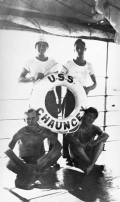 0500310 |
90k | Crew members of the USS Chauncey (Destroyer No. 3), probably taken in the Philippines before World War I. Naval History & Heritage Command photo NH 92639, courtesy of Jack Howland, 1981 | Darryl Baker | |
 0500344 |
110k | USS Chauncey (Destroyer No. 3) mored in Subic Bay, circa 1917. This photo appears to have been taken just before she departed for Europe. Note the copious awnings to deal with the tropic heat. | Dave Wright | |
 0500343 |
147k | USS Chauncey (Destroyer No. 3) and a sister moored in Dewey Drydock, circa 1917. This photo appears to have been taken just before she departed for Europe. Note the copious awnings to deal with the tropic heat, as well as the scoops on the portholes to capture any available breeze. | Dave Wright | |
| Loss of Chauncey |
||||
In the early morning hours of 19 November 1917, Chauncey was steaming some 110 miles west of Gibraltar on a five-mile interval scouting line with Barry (Destroyer No. 2), Castine (Gunboat No. 6) and patrol yacht Yankton. The ships were proceeding at nine knots, expecting to rendezvous with an incoming convoy escorted by scout cruiser Birmingham at 7 A.M. Within one minute of sighting each other, the British cargo vessel Rose and Chauncey, both running without lights, collided at 1:46 A.M., the Rose crashing into the Chauncey on the port side abreast of the fourth funnel. The after portion of the destroyer immediately sank and the officers and men in that part were drowned. After the collision the remaining portion of the vessel floated for about an hour and the transport was thus enabled to rescue the remainder of the officers and crew. They were taken to port by the Rose. To quote the final report of LT(jg) Francis K. O'Brien, Chauncey's executive officer/chief engineer and only surviving officer: I was awakened by D. McGowan, A.B., quartermaster of the watch, and told there was a ship close at hand on the port bow, and as I was getting up, I heard the quartermaster call "full speed" and saw him ring up the telegraph and heard the officer of the deck, Chief Gunner's Mate Leonard R. Smith, give the order "hard right." I got outside the chart house, and, as I had been asleep I could not distinguish things very plainly, but I saw this dark object on the port bow. She was so near I could see the white water being thrown up in front and hear the sound of it. I gave the order "hard left" to swing toward her; at that time we were swinging right and throwing ourselves abeam of her and I wanted to receive a glancing blow if we could not clear. The helmsman answered me, "Hard left, sir," and then we struck. I called the lookouts to untoggle the four cork life rings on the bridge, and ran aft, but could not get any farther aft than the hatch of the C.P.O. compartment, as the decks were submerged. As I turned to go forward, I was knocked up against the life lines by the sea, as we had a following sea at the time. I went back to No. 1 6-pounder, where the men were, and saw them lower the boat and embark. I told the coxswain to go to the merchantman and tell them to send us boats and then to return with our boat. I returned to the bridge and told Smith, who had a megaphone, to call to the merchantman and tell him to back down across our bows and send lifeboats. The merchantman had already lowered lifeboats and one of them came alongside. I took the position from the chart by working back from the rendezvous 45 miles and gave it to the wireless operator, Archie R. Ridlon, third-class electrician, and told him to send the S.O.S. I several times afterwards asked him if he had gotten it through, and he always said, "I am trying, sir." It was soon discovered that the aerial was down. Eugene L. Paysse, second-class hospital apprentice, tried to rig up a makeshift aerial, but was unsuccessful. I called for a searchlight, but it blew a fuse. The engines had been put out of commission by the collision. I gave orders to the water tender to let No. 2 boiler die out and secure. The water tender came up on deck and we both went aft; by this time the water was about up to No. 3 stack, and he said, "Mr. O'Brien, hadn't we better shut this hatch down?" The hatch was just forward of the stack, and we closed it. We then went forward and secured No. 1 boiler, in order to prevent an explosion if we sank. It was about 3 a.m. The ship listed violently and began to settle rapidly. I went up on the forecastle and we saw a lifeboat coming, and I had Smith, who had the megaphone, to tell them to bear a hand, as we could not last much longer. There were eight men and myself on board. A quartermaster named Dunn [Ed Dunn, second-class quartermaster] and myself then went up on the bridge and got the chart, the rough log sheet, the night orders, and our clothes, and went down on the main deck and waiting for the boat got dressed. The ship was searched and the radio man told to leave his station, as we were leaving in the last boat. As I went over the side it was 3.05; I had a navigator's stop watch in my pocket. We had some time getting clear of the side on account of the suction. A few minutes after getting aboard the Chauncey was reported to me as "sunk." I did not see it myself, because I did not look back. It was then 3.17. I asked the captain to circle the spot until dawn, had lookouts assigned for him, and gave him the men with mechanical ability to help him out in the foreholds. Chauncey's last reported position was 35 22' north, 08 30' west. The water there is some 1,500 fathoms deep. She was the first U.S. Navy destroyer to be lost in the line of duty. | ||||
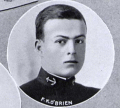 0500342 |
60k | Francis Kendall O'Brien was Chauncey's Executive Officer & Chief Engineer, and her only surviving officer. He was born in Fort Riley, Kansas, 01 October 1892. His father was Army 1st Lieutenant Michael James O'Brien, Fifth Infantry, who was killed in action at Santiago de Cuba, 16 September 1898. Graduating the Naval Academy in 1914, O'Brien first served on Maryland (Armored Cruiser No. 8) before reporting to Chauncey. After her loss, he srved as engineering officer on Ward (Destroyer No. 137) and executive officer of Bagley (Destroyer No. 185) before commanding Meredith (Destroyer No. 165), July-December 1920. O'Brien then served as flag lieutenant to Admiral Edward Simpson in Hawaii, then as executive officer of Pecos (AO-6) in 1924. After a stint on the staff of Commander, Asiatic Fleet, he served as First Lieutenant of Wyoming (BB-32) from 1928-1929. Commanding Yale University's ROTC from 1931-1932, he served as XO of Henderson (AP-1) before assuming command of Ellis (DD-154) in June 1934. O'Brien spent several years on desk assignments in Washington before being appointed XO of Marblehead (CL-12) in April 1938. His next assignment was as officer in charge of the Naval Recruting Station in New York City. During World War Two, he saw service in England before putting Rutland (APA-192) in commission, 29 September 1944. He retired as a Captain 01 November 1946, and died at San Antonio, Texas, 19 August 1981. Captain O'Brien is buried in Arlington National Cemetery. | Dave Wright | |
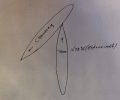 0500317 |
60k | Diagram of the collision between Chauncey and British merchantman Rose, 19 November 1917. Court of Inquiry Record of Proceedings, 21 November 1917, National Archives, Washington, DC, Record Group 45, Entry 520, Chauncey Subject File | Dave Wright | |
 0500315 |
101k | Real photo postcard of USS Chauncey (Destroyer No. 3) survivors, presumably aboard SS Rose. The back of the postcard reads: "This picture was taken aboard the ship that picked us up. Here are the lucky ones. -Jack" | Mary Marconi | |
 0500316 |
56k | Another view of USS Chauncey (Destroyer No. 3) survivors. The sole surviving officer, LT(jg) Francis K. O'Brien, is at center. Photo from Our Navy magazine, May 1918. | Dave Wright | |
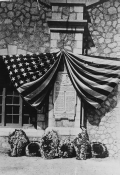 0500318 |
680k | USS Chauncey (Destroyer No. 3) memorial tablet erected by the officers and men of Destroyer Squadron Fifteen in memory of the three officers and eighteen enlisted crewmen lost with Chauncey on 19 November 1917.The tablet is seen here at its dedication at Gibraltar, August 1923. Naval History & Heritage Command photo NH 42002 | Bill Gonyo | |
 0500309 |
97k | USS Chauncey (Destroyer No. 3) memorial tablet erected by the officers and men of Destroyer Squadron Fifteen in memory of the three officers and eighteen enlisted crewmen lost with Chauncey on 19 November 1917. The tablet was placed on Gun Wharf at Gibraltar just after the war. In November 2014, it, along with a tablet commemorating the loss of USS Tampa, was refurbished and moved to the American War Memorial in Gibraltar. Naval History & Heritage Command photo NH 42003 | Bill Gonyo | |
| Chauncey's Lost Crew |
||||
While the following information for Chauncey's lost men only allows for the barest sketches, it is hoped that it gives at least some insight into the background of the sailors killed in the Navy's first loss of World War One. For biographical information on Chauncey's Commanding Officer, LCDR Reno, see Reno (DD-303), and for LT(jg) Charles F. Wedderburn, see Wedderburn (DD-684). | ||||
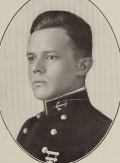 0500328 |
22k | Harry George Skinner, Jr. was born in Baltimore, Maryland, 22 May 1889, the scion of a well-known Baltimore shipbuilding family. Appointed to the Naval Academy with the Class of 1913, Skinner resigned due to defective vision immediately after graduation, 07 June 1913. With the American entry into the Great War, he was appointed an Ensign in
the US Naval Reserve Force at Brooklyn Navy Yard 03 May 1917. Intially assigned to help fit out Nahma (SP-771) 21 June 1917, Skinner was transferred to Chauncey from Nahma at Gibraltar, 06 November 1917, barely two weeks before his untimely death. He was the only one of Chauncey's three lost officers to not have a new destroyer named for him. Photo from 1913 Lucky Bag yearbook | Dave Wright | |
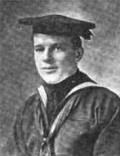 0500329 |
22k | Stanley Thomas Anthony, Electrician 1st Class (Radio) (125 03 27) was born in Connecticut 01 April 1893, but grew up in East Boston and Bedford, Massachusetts. He enlisted in the Navy 25 April 1910. Photo from Our Navy magazine, January 1918 | Dave Wright | |
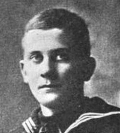 0500330 |
22k | Honore Martin Claggett, Jr., Chief Electrician (G) (195 32 23) was born in Petersville, Maryland 01 March 1894. His family lived near Laurel, Maryland, before moving to Poolesville about 1914. He enlisted in the Navy at Baltimore 19 June 1911. Assigned to Chauncey just before she departed the Philippines 30 June 1917, Claggett was promoted to Chief 17 September 1917. Photo from Our Navy magazine, January 1918 | Dave Wright | |
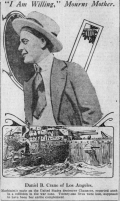 0500331 |
668k | Daniel Bruce Crane, Machinists Mate 2nd Class (123 04 00) was born on Clay Street in Los Angeles, California, 22 January 1897. He served a four year apprenticeship at the Southern Pacific railroad shops before becoming a machinist
at the Llewellyn Iron Works in 1916. Enlisting in the Navy 30 April 1917, Crane departed for the Philippines aboard the Army transport Sheridan 05 June 1917. From there he departed as a crewman on Chauncey 01 August 1917 to meet his fate three months later. He was the first Los Angeles resident to lose his life in the Great War. Article from the Los Angeles Times, 21 November 1917 | Dave Wright | |
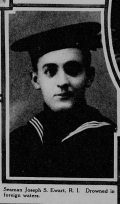 0500332 |
348k | Joseph Sharp Ewart, Machinsts Mate 1st Class (125 54 59) was born in Newport, Rhode Island, 01 February 1894. He enlisted in the Navy 04 February 1915, and has a cenotaph in the Newport Common Burying Ground. Photo from the New York Tribune, 16 June 1918 | Dave Wright | |
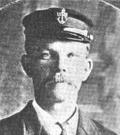 0500333 |
14k | Charles Albert Goodrich, Chief Machinists Mate (145 71 36) was born in Ottawa, Kansas, 01 May 1873. Enlisting in the Navy at Los Angeles, 10 December 1900, Goodrich spent the bulk of his career on destroyers, serving on Farragut, Preble, Perry and Paul Jones before being assigned to Chauncey. He is said to have declined an officer's commission to remain an enlisted man. Photo from Our Navy magazine, January 1918 | Dave Wright | |
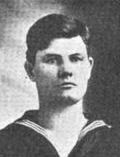 0500334 |
9k | Algen Hysle Guttridge, Machinsts Mate 2nd Class (105 90 89), was born in Kenton County, Kentucky 23 May 1880, and grew up in Culison, Kansas. He enlisted in the Navy 30 November 1904, and has a cenotaph in Greenlawn Cemetery, Pratt County, Kansas. Photo from Our Navy magazine, January 1918 | Dave Wright | |
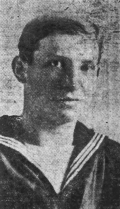 0500335 |
161k | Henry George Haman, Seaman 1st Class (115 76 58) was born in Buffalo, New York's First Ward 14 October 1897. He enlisted in the Navy 21 November 1914, serving on battleship California before transferring to Chauncey. Photo from the Buffalo Inquirer, 22 November 1917 | Dave Wright | |
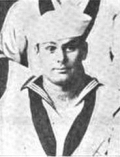 0500336 |
9k | William Herman Hampel, Machinsts Mate 2nd Class (176 21 37) was born about 1887 in Chicago, Illinois. Growing up in De Pere, Wisconsin and Randville, Michigan, Hampel enlisted 15 April 1910. Photo from Our Navy magazine, January 1918 | Dave Wright | |
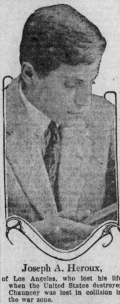 0500337 |
168k | Joseph Adolphe Heroux, Fireman 3rd Class (106 02 89) was born in Montreal, Quebec 27 July 1899. He came to Los Angeles wih his grandparents in 1910, attneding the Los Angeles Military Academy. Heroux initially attempted to join the aviation branch of the Army, but for unexplained reasons went into the Navy instead.
He enlisted 31 January 1917 and sailed to Manila on Army transport Logan that May. Photo from the Los Angeles Times, 22 November 1917 | Dave Wright | |
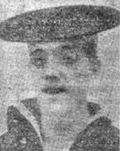 0500338 |
11k | Ira Francisco Kopp, Gunners Mate 1st Class (126 07 59) was born in Davenport, Iowa, about 1887, and enlisted in the Navy 16 May 1906. Photo from Our Navy magazine, January 1918 | Dave Wright | |
Available | - | Charles Albert O'Connor, Chief Yeoman (166 65 09), was born in Woburn, Massachusetts, 24 October 1893, and enlisted (probably for a second term) 01 September 1914. | Dave Wright | |
Available | - | Francisco M. Pagtakhan, Mess Attendant 3rd Class (152 07 78) was a native of Olongapo, Philippines, and enlisted 31 July 1917, shortly before Chauncey departed his homeland for European waters. | Dave Wright | |
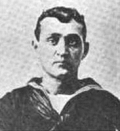 0500339 |
11k | John Rhinehart, Chief Water Tender (106 88 75) was born in New Jersey about 1870. He joined the Navy about 1896, serving on several ships, including battleship Tennessee, before joining the crew of Chauncey. Photo from Our Navy magazine, January 1918 | Dave Wright | |
Available | - | John Aloysius Smith, Gunners Mate 1st Class (167 10 38), is a bit of an emigma by virtue of his common name. He enlisted, likely for a second term, at New York, 10 July 1907. | Dave Wright | |
Available | - | John William Stribling, Machinsts Mate 2nd Class (167 23 43), was a native of Waring, Texas, and enlisted in the Navy 26 October 1911. | Dave Wright | |
Available | - | Oswald Jager Terkildsen, Yeoman 2nd Class (107 24 12), was born in Brooklyn, New York, 28 july 1897, the son of first generation Norwegian immigrants. He enlisted at Brooklyn Navy Yard 27 November 1914. | Dave Wright | |
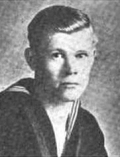 0500340 |
9k | Nicholas Henry Joseph Wagner, Ship Fitter 1st Class (177 50 73) was a native of Fullerton, Maryland. He enlisted 03 June 1914. Photo from Our Navy magazine, January 1918 | Dave Wright | |
Available | - | George Wornell, Boilermaker (134 57 08) is another enigma. He enlisted, likely for a second or third term, at San Francisco 25 October 1915. | Dave Wright | |
| Commanding Officers | ||
| 01 | LT Stanford Elwood Moses (USNA 1892) | 21 February 1903 - 21 August 1903 |
| 02 | ENS Samuel Brown Thomas (USNA 1899) | 21 August 1903 - 06 September 1903 |
| 03 | LT Stanford Elwood Moses (USNA 1892) | 06 September 1903 - 14 May 1904 |
| 04 | ENS Samuel Brown Thomas (USNA 1899) | 14 May 1904 - 26 July 1904 |
| 05 | LT Earl Percy Jessop (USNA 1896) | 26 July 1904 - 26 June 1905 |
| 06 | ENS Joseph Rollie Defrees (USNA 1900) | 26 June 1905 - 03 December 1905 |
| Decommissioned | 03 December 1905 - 12 January 1907 | |
| 07 | MACH Fred Walter Cobb USN | 12 January 1907 - 19 January 1907 |
| 08 | LT Frank Robert McCrary (USNA 1901) | 19 January 1907 - 20 July 1908 |
| 09 | LT James Harvey Tomb (USNA 1899) | 20 July 1908 - 10 June 1909 |
| 10 | ENS Laurance North McNair (USNA 1905) | 10 June 1909 - 11 September 1911 |
| 11 | ENS John Craig Cunningham (USNA 1908) | 11 September 1911 - 31 March 1912 |
| 12 | LT Frank Jack Fletcher (USNA 1912) | 31 March 1912 - 11 September 1912 |
| 13 | ENS John Craig Cunningham (USNA 1908) | 11 September 1912 - 12 October 1912 |
| 14 | ENS Eugene Morris Woodson (USNA 1909) | 12 October 1912 - 22 October 1912 |
| 15 | LT(jg) Richard Hill (USNA 1907) | 22 October 1912 - 31 January 1913 |
| 16 | ENS Eugene Morris Woodson (USNA 1909) | 31 January 1913 - 24 January 1914 |
| 17 | LT(jg) John Calvin Jennings (USNA 1908) | 24 January 1914 - 22 December 1915 |
| 18 | LT George Hall Bowdey (USNA 1907) | 22 December 1915 - 09 May 1916 |
| 19 | LT Walter Elsworth Reno (USNA 1905) | 09 May 1916 - 19 November 1917† |
|
Courtesy David Wright |
| Back To The Main Photo Index | To The Destroyer Photo Index Page |
|
This page was created by Fred Willishaw (ex ARG-4, AS-11 & DD-692) and is maintained by David L. Wright |